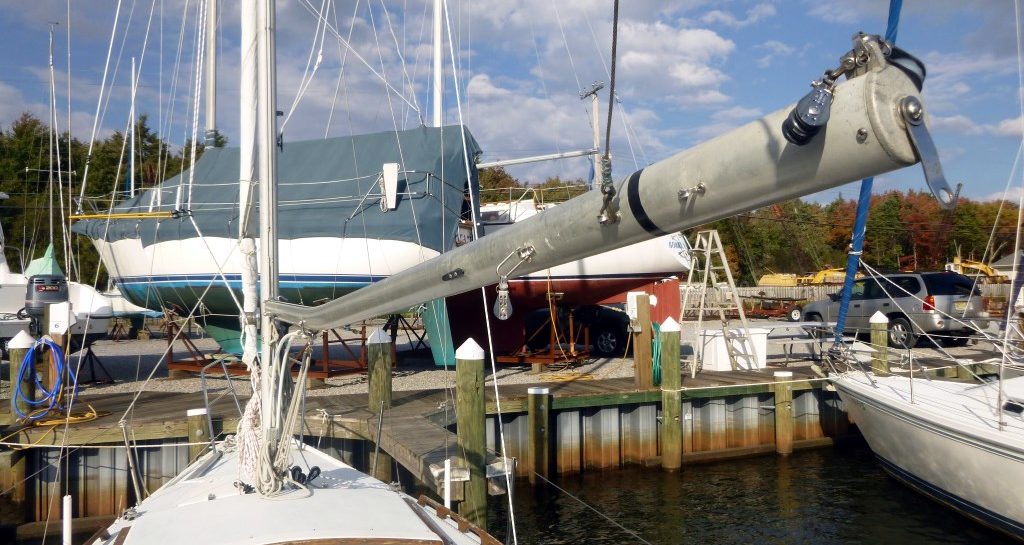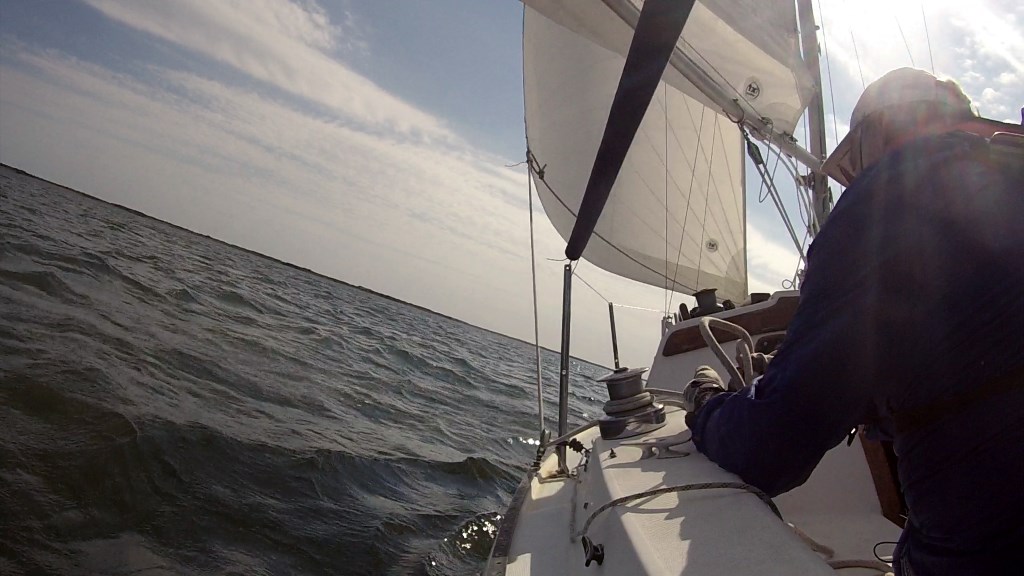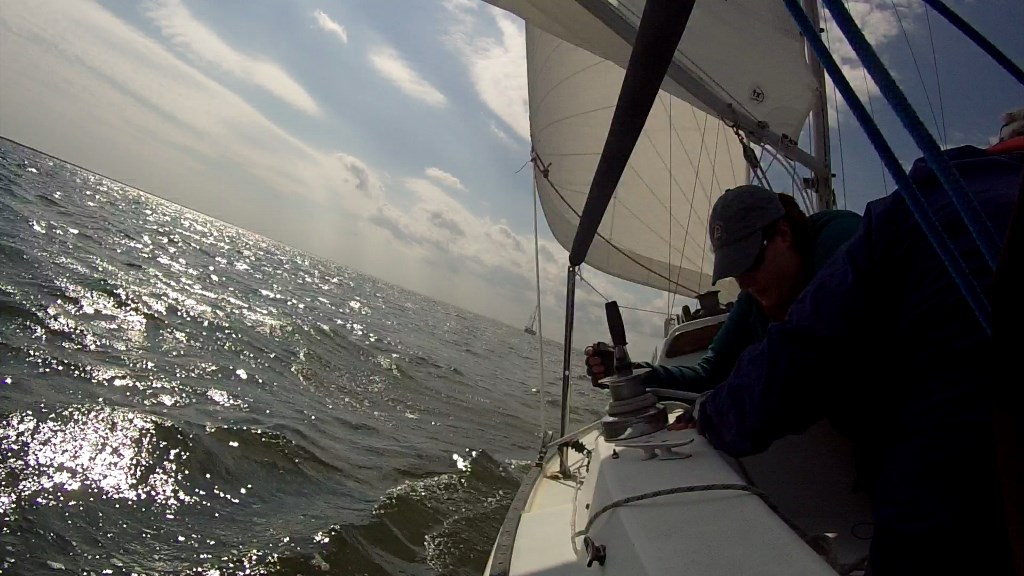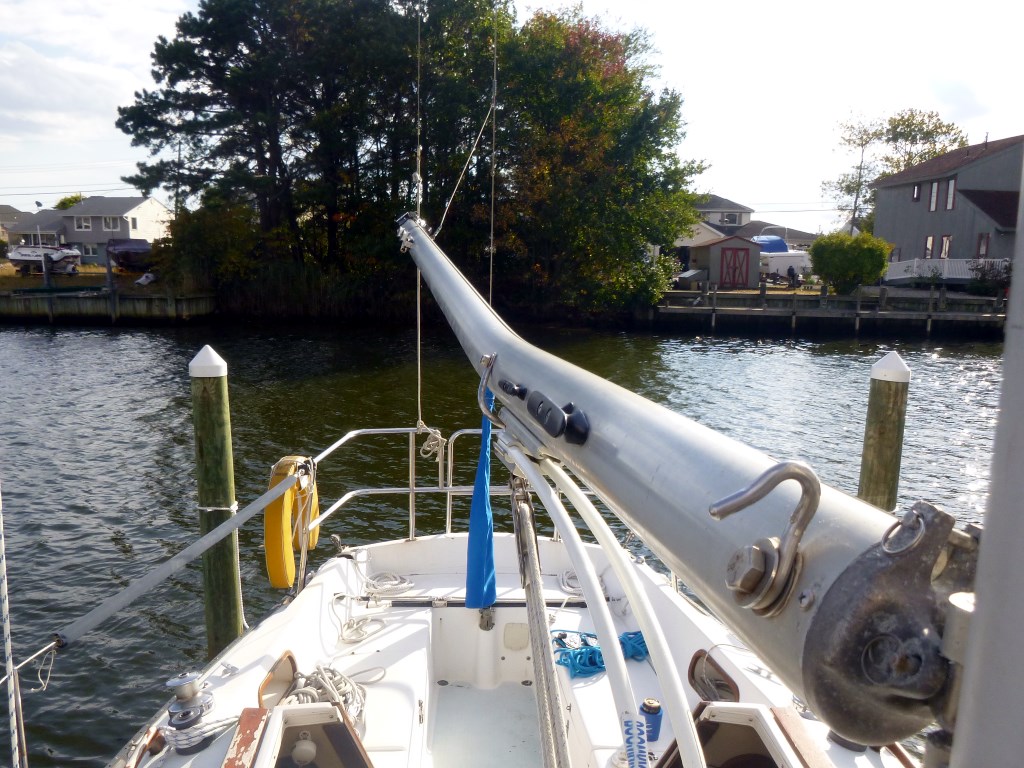
This weekend was the Windjammers’ annual Frostbite Race. Our participation was brief.
The Frostbite Race is the last race on the calendar. Given that the marina closes November 1st, it had the potential to be our last sail of the season, so we were really looking forward to getting out there and mixing it up. The Frostbite race has a bit of a reputation: I think the closest I’ve ever come to sailing in an actual gale was the Frostbite Race of 2011, crewing on Providence II, although we weren’t expecting anything close to that this weekend. It was unseasonably warm and the air was nearly still in the marina when we arrived a little after 1000. We met up with Sailor Steve and went to the captains’ meeting to discuss the course. There was no committee boat, so the racers agreed that we would have an unofficiated gentleman’s start at 1230, GPS time.
All of my beer had somehow disappeared, so I went for a quick beer run. Both of our sets of boat keys were in the truck, leaving Jen unable to prep the boat while I was gone. We quickly got things ready when I got back and headed off. The prediction was for winds in the low 20s and I thought about reefing at the dock, but it was still so calm we elected to just go and see what it was doing out there.
The wind came up quickly as we motored out the creek, and we tucked in a reef as we raised the main. I forgot that the reefing line needed to be tied to the boom as well as the cringle, so we had to fasten that after the fact.
We sailed around for a bit on just the main, tracing the course and making sure we knew where the marks were. I didn’t want to tire out the crew by tacking a lot prior to the race, so we didn’t attempt to deploy the jib until about 25 minutes before the start. I might have waited longer, but wanted to see if there was a favored side—the course was set up pretty well and it wasn’t immediately obvious if there would be one tack that would get us to the windward mark more directly. When we did finally attempt to set the jib, it wouldn’t unfurl.
This happened once before, on our sail to Atlantic City, but we’d successfully used the jib since then and I thought that we were in the clear. None of the usual things worked, like adjusting the halyard tension or pulling on the backstay to try to adjust the forestay tension (we don’t have a proper backstay adjuster on this boat yet). I think Sailor Steve attempted to ease the main halyard too, in case that was somehow involved. Nothing we did worked. With time ticking, we decided to manually unfurl the headsail just to get through the race. To Jen’s delight, I asked her to take the helm while Sailor Steve and I went forward. We tried to roll the jib on itself up as we unrolled it from the forestay to keep it more compact and manageable, but it was gusting to 20kts by that point and it quickly got away from us. I had to give course consultation to Jen (knowing that we had to stay relatively close to the starting line), manhandle the sail, and try to stay on the boat despite the building whitecaps. Mostly through Steve’s efforts, we were eventually able to get it unwound, intentionally leaving a couple wraps on since it would be very difficult to reef if the wind kicked up much more. After reattaching and routing the sheets, I relieved Jen at the tiller.
The main halyard was still loose, and I asked for it to be tightened. Sailor Steve tried to hoist it with the cabin top winch, but he couldn’t get it to go. It clearly was still slack at the luff, and I thought that his difficulties were due to the fact that we weren’t motoring head to wind and that the side force on the slugs was making it hard to draw up the last few inches. We messed with the main sheet to try to lessen the pressure and eventually headed the boat up to try to get it, but even with Herculean grinding, we eventually just left it slightly loose…if there had been a starting sequence, we would have already been in it, and we just didn’t have any time.
At the line with 5 minutes to go, my plan was to sail a beam reach to the north for about half the remaining time, tack through 180°, then come back and hit the line sailing fast on starboard. When the time came to tack, there was a boat sitting on our port quarter, so at the last minute I instead called for a jibe. We jibed cleanly, leaving us in a good position, leeward of the other boat.
It was about then that I had a trainwreck of near simultaneous thoughts that went something like “The-boom-is-riding-high-can-you-please-tighten-the-vang-oh-shit-the-boom-is-bent.”
Indeed, the boom was quite bent. I couldn’t see the extent of the damage because the loose portion of the sail below the reef was obscuring the boom, but the vang was on hard, the first few feet of the boom appeared to be horizontal, and the aft part was pointing toward the sky at a disturbingly high angle. I immediately had a mental image of half a cracked boom flogging about the cockpit and striking us like a drunken riot cop’s baton, so I ordered the sail down in a terse sequence of pantomime and profanity. Dropping the sail was also somewhat panicked—Jen had apparently asked me questions that failed to register with me as I went into disaster recovery mode—but we got it down, relieved the pressure from the boom, and started to think through the next steps.
I started the engine and informed the de-facto committee boat that we were resigning. The issue was that we were still out there with a genoa that we couldn’t furl. Ordinarily, when you unfurl a sail the foil turns and the furling line is wound around the drum, then you can pull the furling line to bring the sail back in. In this case, since we had manually unfurled the sail, there was no line on the drum and we couldn’t use it to stow the sail. We also couldn’t simply rotate the foil by hand because the whole nature of the original problem was that the foil wouldn’t turn. I knew that this was the case when we made the decision to manually unfurl, and had planned to simply drop the sail to the deck, as we did in Atlantic City previously. Of course, this time it wouldn’t budge.
I stayed at the helm on this go-around and Jen and Steve went forward to work on it. They were pulling down on the sail with everything that they had. Nothing. The halyard wouldn’t move in either direction either. The crew considered trying to manually re-wind the sail, which is even less straightforward than unwinding it. I was petrified that we’d lose track of a sheet and suck it into the prop, which would have left us only with the “throw out the anchor and hope” option for staying off the beach. I considered how difficult it might be to dock in a 20kt cross wind with a flogging 135 (taking into account that the Island Packet in the slip next to us has already been pulled for the season), but we decided to manually furl the sail, or at least try to get it most of the way there.
I powered us as slowly as I could into the wind to try to keep the sail streaming back. Too little power and the wind would tend to push us off to one side or the other; too much power and we started pounding through the chop, which is not conducive to keeping your foredeck crew aboard. We crept almost all the way back to the creek before they got it in to the point where they could lash it down, but they got it. I was so glad that I remembered to get beer.
I docked like we were coming into a hot LZ. It’s probably disconcerting for the crew when the skipper says “this is going to be bad” and applies a whole lot of throttle just as the boat is approaching the pilings, but I stuck it with copious reverse and we started pulling things apart to see what went wrong.
With binoculars, we could see that there were several wraps of halyard around the forestay above the foil, but no amount of twisting or halyard play could get it sorted. It’s probably knotted or seriously jammed up there. Neither Val nor Tom could get it down either, which curiously made the thoroughness of this screwup somehow vindicating. When we finally got the mainsail off, we found the state of the boom to be ridiculous.
Oops.
I’m still not sure exactly how it got bent. I imagine that something happened in the order of operations when we reefed, that the reefing line and vang were both too tight, and that when we tried to force the halyard, the boom is what gave. Maybe the jibe put it over the edge. I’m pretty confident that the stupid boom kicker exacerbated the problem, since 1) it makes it difficult to determine when the vang is in the neutral position and 2) because the rods aren’t exactly the same strength, which twists the boom and allows forces to act on it in its weaker dimension (it’s an oval, and is much stronger on its major axis).
So…racing. Always a learning experience.
In retrospect, I should have gotten more help and fixed the halyard in a more permanent way after we had our problems on our AC trip. It probably needs a retainer to increase the break angle at the spinner. I also should have paid more attention to the big picture when we were having trouble getting the main sail to full hoist, rather than just stare at puckered luff and ask the only member of the crew who lifts weights to force it. I’d like to say that we shouldn’t have let the pressure of competing in the race affect our decision making process, although I know that this is a complete fantasy and will never happen.
On the positive side, we did safely make it back under our own power. I think we maintained some definition of calm throughout the ordeal, and did the best we could to think through our options despite the compounding problems. I felt bad for dragging Sailor Steve all the way to the shore just to have everything break, but was really glad he was there to help. The whole team worked well together under some trying circumstances.
It was disappointing to not race, and it’s very disappointing that this is how our season came to an end. It’s one thing to go out with a bang, but it’s quite another to go out with a bend. I wasn’t even sure if I was going to write about this—when the mast was broken on our 22, I didn’t write about it until months later, and even then I kind of glossed over it. I was feeling kind of dumb about the whole thing and didn’t really want to talk about it, but it was a long winter with a broken boat. I’ve taken a few days to let this sink it, but I’m going to try to get past it and focus on the things that we still need to do to get our boat repaired and winterized. At least it happened at the end of the season. I guess I’ll have plenty of time to draw up a new boom, with a proper topping lift and no stupid boomkicker, and start running down the boat fund in earnest.
Thanks again to Jen and Sailor Steve for racing this year. Hopefully we can give it another go in 2015. In the mean time, I’m sure I’ll have lots of exciting maintenance entries.



I guess we can assume that your boom vang is of more than sufficient strength.
Yeah, no need to go to hi-tech line there, apparently. 🙂
Thanks for all your help Steve.
Hell of a way to end a season Team Fortuitous! I’m thinking all those penetrations in your boom were a contributing factor to the bending. Add in your vang pulling against the stupid boom kicker, a jibe in strong wind while reefed and voila! I’m just glad none of this happened to you while “outside”.
Calebd
Yeah, who knows. The jibe wasn't all that hard but the vang may have been on too much. It was always hard for me to tell with the boomkicker, since the vang had to be on all the time to keep the boom from riding up like crazy.